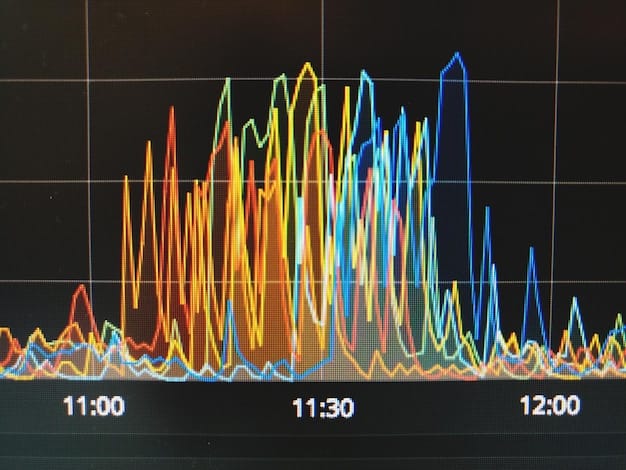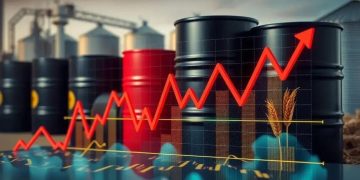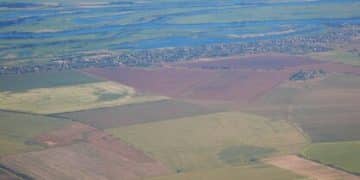US Fertilizer Market: Decoding the 12% Nitrogen Fertilizer Price Increase

The US fertilizer market is facing a projected 12% price increase for nitrogen fertilizers due to a combination of factors, including rising natural gas prices, supply chain disruptions, and geopolitical tensions, impacting farmers and agricultural economics.
The US fertilizer market is bracing for a significant shift as projections indicate a 12% price increase for nitrogen fertilizers. This surge poses potential challenges for farmers and the broader agricultural sector.
Understanding the Nitrogen Fertilizer Market in the US
The agricultural sector in the United States heavily relies on fertilizers, particularly nitrogen-based ones, to sustain crop yields. Understanding the dynamics of this market is crucial for both farmers and policymakers.
Nitrogen fertilizers are essential for plant growth, contributing to the production of key crops such as corn, wheat, and soybeans. These fertilizers are derived from ammonia, which is produced using natural gas. Therefore, fluctuations in natural gas prices significantly impact the cost of nitrogen fertilizers.
The US fertilizer market is susceptible to global trends, including supply chain disruptions and geopolitical tensions.
Key Drivers of Nitrogen Fertilizer Prices
Several factors influence the price of nitrogen fertilizers in the US, affecting farmers’ operational costs and the overall agricultural economy.
- Natural Gas Prices: As a primary input in ammonia production, the cost of natural gas plays a pivotal role in determining nitrogen fertilizer prices.
- Supply Chain Disruptions: Disruptions in the global supply chain, exacerbated by events such as the COVID-19 pandemic, can lead to increased fertilizer costs.
- Geopolitical Tensions: Conflicts and political instability in key fertilizer-producing regions can also contribute to price volatility.
The interconnectedness of these factors creates a complex landscape for the agricultural sector, requiring stakeholders to remain vigilant and adaptable.
In conclusion, understanding the nitrogen fertilizer market in the US involves comprehending the interplay between natural gas prices, supply chain dynamics, and geopolitical influences. These elements collectively shape the economic landscape for farmers and the broader agricultural industry.

The Impact of Natural Gas Prices on Fertilizer Costs
Natural gas is a critical component in the production of nitrogen fertilizers, making its price a significant determinant of fertilizer costs. Fluctuations in natural gas prices directly affect the affordability of fertilizers for farmers.
Ammonia, the building block of nitrogen fertilizers, is synthesized using natural gas as a feedstock. Therefore, any increase in natural gas prices translates to higher production costs for fertilizer manufacturers, which are then passed on to consumers.
The shale gas revolution in the US has led to increased domestic production of natural gas, impacting the fertilizer industry. However, global market dynamics still play a crucial role in determining natural gas prices.
Strategies for Farmers to Mitigate Natural Gas Price Impact
Given the volatility of natural gas prices, farmers can adopt strategies to mitigate the impact on their operational costs.
- Optimize Fertilizer Application: Implementing precision agriculture techniques to ensure efficient fertilizer use can reduce overall consumption.
- Explore Alternative Fertilizers: Consider using organic or slow-release fertilizers to reduce reliance on nitrogen-based products.
- Hedge Against Price Fluctuations: Utilize financial instruments to hedge against potential price increases in natural gas or fertilizers.
By implementing these strategies, farmers can better manage their fertilizer expenses and improve their overall profitability.
In summary, the impact of natural gas prices on fertilizer costs is substantial, necessitating proactive measures by farmers to mitigate the financial strain. By optimizing fertilizer application, exploring alternative options, and hedging against price fluctuations, farmers can enhance their resilience in the face of market volatility.
Supply Chain Disruptions and Fertilizer Availability
Supply chain disruptions have emerged as a significant concern for the US fertilizer market, affecting the availability and cost of these essential agricultural inputs.
The COVID-19 pandemic exposed vulnerabilities in the global supply chain, leading to logistical bottlenecks and increased shipping costs. These disruptions have particularly impacted the fertilizer industry, which relies on international trade for raw materials and finished products.
Port congestion, transportation delays, and labor shortages have further exacerbated supply chain challenges, resulting in higher fertilizer prices and limited availability for farmers.
Strategies for Farmers to Navigate Supply Chain Challenges
To navigate supply chain disruptions, farmers can employ various strategies to ensure a stable supply of fertilizers.
- Plan Ahead: Purchase fertilizers well in advance of the planting season to avoid potential shortages and price increases.
- Diversify Suppliers: Establish relationships with multiple fertilizer suppliers to reduce dependence on a single source.
- Collaborate with Cooperatives: Join agricultural cooperatives to leverage collective purchasing power and gain access to fertilizer supplies.
By adopting these strategies, farmers can mitigate the impact of supply chain disruptions on their operations and ensure timely access to fertilizers.
In conclusion, supply chain disruptions continue to pose challenges for the US fertilizer market, affecting both availability and prices. By planning ahead, diversifying suppliers, and collaborating with cooperatives, farmers can enhance their resilience and secure a reliable supply of fertilizers.

Geopolitical Tensions and Global Fertilizer Prices
Geopolitical tensions play a significant role in shaping global fertilizer prices, influencing the stability of supply chains and market dynamics.
Conflicts and political instability in key fertilizer-producing regions can disrupt production and trade flows, leading to price volatility and uncertainty for farmers. For example, sanctions imposed on major fertilizer exporters can restrict supply, driving up prices.
Trade disputes and tariffs can also impact fertilizer prices, as they create barriers to international trade and increase costs for importers. Geopolitical tensions can create unpredictable market conditions, making it challenging for farmers to plan their fertilizer purchases.
Examples of Geopolitical Factors Affecting Fertilizer Prices
Several examples illustrate the impact of geopolitical factors on fertilizer prices:
Sanctions on Major Exporters: Economic sanctions imposed on countries that are significant fertilizer exporters can restrict supply, leading to price increases.
Trade Disputes: Trade disputes between major economies can result in tariffs on fertilizer imports, raising costs for farmers.
Political Instability: Political instability in fertilizer-producing regions can disrupt production and trade, causing price volatility.
By understanding these geopolitical factors, farmers can better anticipate market trends and make informed decisions about fertilizer purchases.
In summary, geopolitical tensions exert a considerable influence on global fertilizer prices, affecting supply chains and market dynamics. By monitoring these factors, farmers can better prepare for potential price fluctuations and supply disruptions, ensuring the stability of their operations.
Strategies for Farmers to Manage Fertilizer Costs
Farmers can implement several strategies to effectively manage fertilizer costs and enhance the profitability of their operations.
Optimize Fertilizer Application: Implementing precision agriculture techniques to ensure efficient fertilizer use can significantly reduce overall consumption.
Explore Alternative Fertilizers: Consider using organic or slow-release fertilizers to reduce reliance on nitrogen-based products.
Negotiate with Suppliers: Establish relationships with multiple suppliers and negotiate favorable pricing terms to lower costs.
By adopting these strategies, farmers can better control their fertilizer costs and improve their financial performance.
Technologies and Practices for Efficient Fertilizer Use
Several technologies and practices enable farmers to use fertilizers more efficiently:
- Precision Agriculture: Utilize GPS-guided equipment and sensors to apply fertilizers precisely where they are needed, reducing waste.
- Soil Testing: Conduct regular soil tests to determine nutrient levels and tailor fertilizer applications to specific crop requirements.
- Variable Rate Application: Apply different fertilizer rates to different areas of the field based on soil conditions and crop needs.
By leveraging these technologies and practices, farmers can optimize fertilizer use and minimize environmental impacts.
In conclusion, strategies for managing fertilizer costs encompass optimizing application techniques, exploring alternative products, and negotiating with suppliers. By leveraging precision agriculture and conducting regular soil testing, farmers can enhance their efficiency and reduce fertilizer expenses.
Long-Term Outlook for the US Fertilizer Market
The long-term outlook for the US fertilizer market is shaped by various factors, including technological advancements, sustainability initiatives, and evolving market dynamics.
Technological advancements in fertilizer production and application are expected to improve efficiency and reduce environmental impacts. Innovations such as enhanced efficiency fertilizers and precision agriculture techniques will play a crucial role in optimizing fertilizer use.
Sustainability initiatives aimed at reducing greenhouse gas emissions and promoting environmental stewardship are also influencing the fertilizer market. Farmers are increasingly adopting sustainable practices, such as cover cropping and reduced tillage, to improve soil health and reduce fertilizer runoff.
Future Trends and Innovations in the Fertilizer Industry
Several future trends and innovations are poised to transform the fertilizer industry:
- Enhanced Efficiency Fertilizers: These fertilizers release nutrients gradually, reducing nutrient loss and improving crop uptake.
- Precision Agriculture Technologies: Advanced sensors and data analytics enable farmers to apply fertilizers with greater precision, minimizing waste and maximizing yields.
- Sustainable Farming Practices: Techniques such as cover cropping, crop rotation, and reduced tillage enhance soil health and reduce the need for synthetic fertilizers.
By embracing these trends and innovations, the US fertilizer market can become more sustainable and efficient.
In summary, the long-term outlook for the US fertilizer market is characterized by technological advancements, sustainability initiatives, and evolving market dynamics. By embracing these trends and innovations, the industry can enhance its efficiency, reduce environmental impacts, and ensure a sustainable future for agriculture.
| Key Point | Brief Description |
|---|---|
| ⛽ Natural Gas Prices | Natural gas costs directly impact nitrogen fertilizer production. |
| 🚚 Supply Chain | Disruptions affect availability and raise fertilizer prices. |
| 🌍 Geopolitical Factors | Tensions and trade disputes influence global fertilizer markets. |
| 🚜 Cost Management | Strategies include optimizing application and exploring alternatives. |
Frequently Asked Questions
▼
Nitrogen fertilizer prices are rising due to a combination of factors, including increasing natural gas prices (a key input), supply chain disruptions, and geopolitical tensions which impact global trade flows.
▼
Natural gas is a primary component in the production of ammonia, which is used to make nitrogen fertilizers. Higher natural gas prices increase the production costs, leading to higher fertilizer prices for farmers.
▼
Farmers can optimize fertilizer application through precision techniques, explore alternative fertilizers like organic options, negotiate with suppliers for better prices, and participate in cooperative purchasing to lower expenses.
▼
Geopolitical tensions and trade disputes can disrupt fertilizer supply chains, leading to price volatility. Sanctions on exporting countries or trade tariffs increase costs and create uncertainty in the market.
▼
The long-term outlook involves technological improvements, sustainability initiatives, and market changes. Enhanced efficiency fertilizers and precision agriculture are expected to reduce environmental impact and improve efficiency.
Conclusion
In conclusion, the projected 12% price increase for nitrogen fertilizers in the US is driven by a combination of factors, including rising natural gas prices, supply chain disruptions, and geopolitical tensions. Farmers can mitigate these challenges through strategic planning, efficient application techniques, and exploration of alternative fertilizer options to ensure sustainable and profitable agricultural practices.





